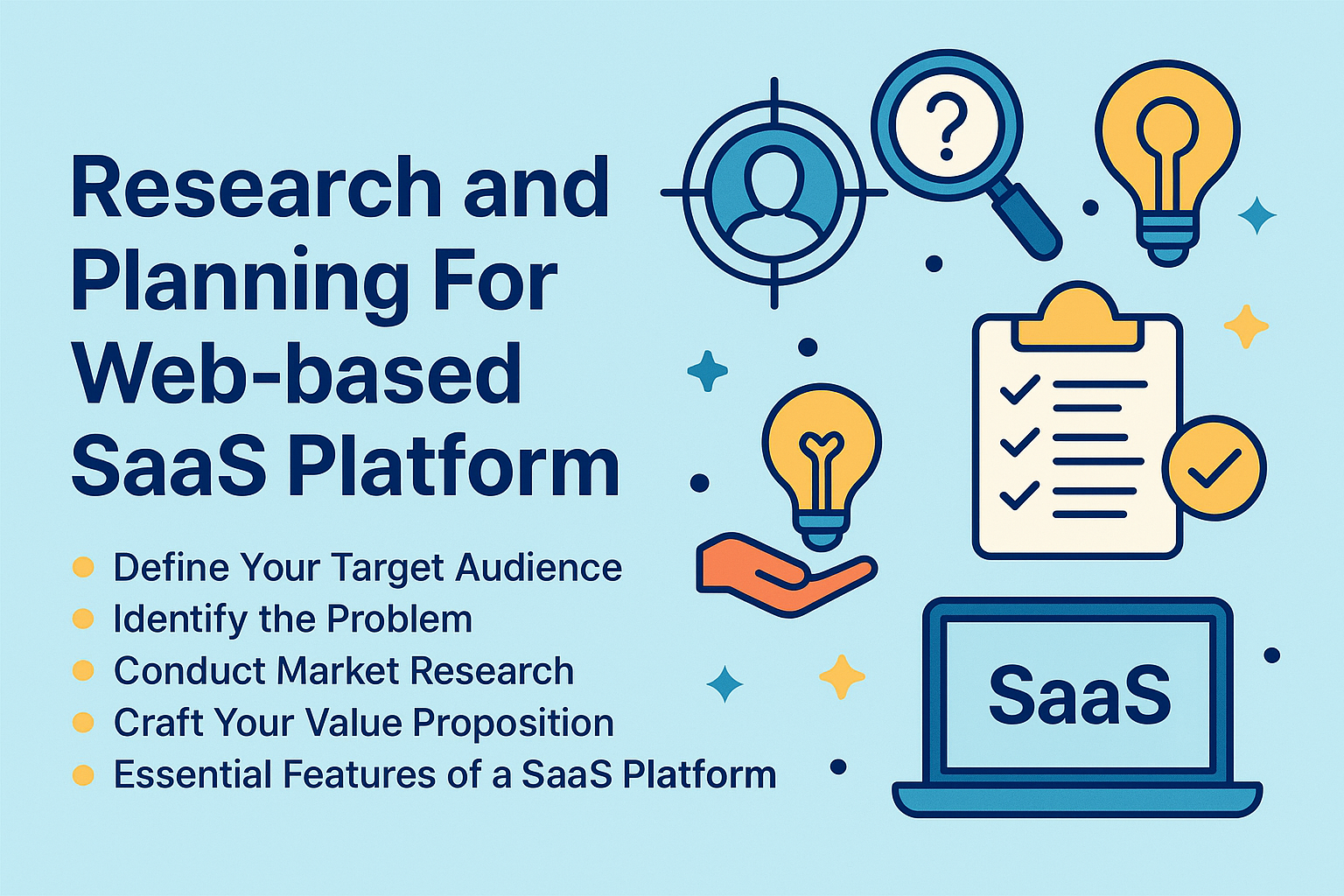
Table of Contents
How to Build a Web-Based SaaS Platform
By allowing companies to use sophisticated tools and services free from the weight of maintaining complicated infrastructure, SaaS (Software-as-a-Service) has profoundly changed the way companies run. Offering scalable, reasonably priced, cloud-based solutions, SaaS has evolved into a pillar of contemporary technology-driven companies.
One particularly noteworthy web-based SaaS platform is one that offers software services straight via a browser. For both companies and people, this removes the need for on-site servers or labor-intensive installations, thereby streamlining their choice. Its adaptability and simplicity of use enable users to concentrate on their main responsibilities while the platform does the hard work.
This paper will discuss the detailed method of creating a profitable web-based SaaS platform. From choosing the correct tech stack to including necessary capabilities, you will obtain practical knowledge to build a strong and scalable SaaS solution fit for your target market.
What is SaaS
Modern software distribution models called SaaS, or Software-as-a-Service, let consumers access apps subscription-based via the internet. SaaS offers a seamless experience for both companies and individual users, unlike conventional software, therefore removing the need for large installations or maintenance. Software as a Service (SaaS) is a cloud-based software delivery model where applications are hosted by a service provider and accessed by users over the internet, typically through a web browser. Instead of purchasing and installing software locally on individual devices, customers subscribe to the software and use it online, which offers flexibility and scalability , and reduces the need for in-house IT infrastructure
Key Characteristics of Web-based SaaS Platforms
- Subscription-Based Pricing
Usually running on a subscription basis, SaaS systems let customers pay regular fees. Subscription-Based Pricing can be set either monthly or annually. Users of this method may adjust their consumption and expenditures according to their demands, therefore making it affordable and easily available.
- Multi-Tenancy Architecture
One instance of the program benefits many consumers or companies. The system separates and secures each tenant’s information, ensuring anonymity and optimal resource utilization for the service provider.
- Continuous Updates
SaaS systems strive for constant improvement. Automatic deployment of updates and new features eliminates user-end manual installs or downtime requirements.
- Scalability
A pillar of SaaS systems, scalability lets them easily sustain an increasing user base. The platform constantly changes to fit demand regardless of your 10,000 or 100,000 user count, therefore preserving performance.
Steps to Build a Web-Based SaaS Platform
1. Validate Your Idea and Market
- Investigate the market to learn trends, demand, and competition.
- Identify the pain points and focus on your target audience.
- Review rivals to create your own unique value proposition (UVP).
2. Define Product Requirements and Plan
- Using a value proposition, target market description, and issue statement, clearly define your idea.
- Create a business plan with objectives, features, and a monetizing approach.
3. Prioritize and Select Features
- Sort and rank features according to user need, effect, and viability.
- Typical essential elements include user authentication, data security, an intuitive UI, and customer support.
- Sort using MoSCoW or RICE to give priorities top importance.
4. Choose the Right Technology Stack
- Backend: Node.js, Django, and Ruby on Rails are common choices.
- Frontend: React.js, Angular.js, and Vue.js for interactive interfaces.
- Database: PostgreSQL, MySQL, or managed solutions like Neon PostgreSQL.
- Hosting/Infrastructure: AWS, Google Cloud, Azure, Digital Ocean, or platforms like Heroku.
- Authentication/Security: Use services like Firebase, Auth0, or Django Allauth for secure user management.
5. Assemble Your Development Team
- Gather developers, designers, and product managers with SaaS experience.
- Consider starting with a small, agile team for MVP development.
6. Develop the SaaS Application
- Start with an MVP focusing on core features.
- Implement authentication, payment integration (e.g., Stripe), and core business logic.
- Use modern frameworks and best practices for code structure and maintainability.
7. Test and Deploy
- Rigorously test for bugs, security, and scalability.
- Deploy to a reliable cloud platform.
- Set up monitoring and analytics for performance and user behavior.
8. Launch and Iterate
- Launch the MVP to early users and gather feedback.
- Iterate on features and UX based on real-world usage.
- Plan for scaling, updates, and customer support as your user base grows.
Research and Planning For web-based SaaS platform
Strategic planning and extensive research are the first steps in creating a successful web-based SaaS platform. These first actions guarantee that your platform satisfies the demands of its target market and provide the basis for future expansion.
Define Your Target Audience
Successful operation of your platform depends on knowing who your target audience is. Various user groups have particular requirements and expectations.
- Small businesses should search for reasonably priced, simple ways to increase output.
- Enterprise Customers: Demand strong, scalable systems with integrated technologies and enhanced capabilities.
- Individuals and Freelancers: Look for simple tools to ease certain chores.
- Reducing your emphasis helps you to match the features and message of your platform to the target demographic.
Identify the Problem
The value of your SaaS platform depends on precisely identifying the particular issues it will handle. Think of
- What typical difficulty does your target audience experience?
- How may your platform provide a better solution than current choices?
- Could you take advantage of any holes in the present market?
The basis of your platform will be stronger the more exact your issue identification is.
Conduct Market Research
Understanding industry trends and seeing possibilities in market research allows you to develop a competitive advantage. Actions to follow consist of:
- Examine competitors’ strengths, shortcomings, pricing strategies, and user comments.
- Point out market gaps. That is, areas or features people often want but are not readily accessible.
- Study User Preferences: Find out via analytics, polls, and interviews what is important to your audience.
This study guarantees that your platform stands out from rivals and fits market needs.
Craft Your Value Proposition
What distinguishes your SaaS platform is a convincing value proposition. Why should people choose your platform over others? Your value offer should stress:
- Special qualities or skills
- Efficiency or economy of cost
- Improved client support or user experience
“Our platform simplifies project management with AI-driven insights, helping teams save 20% more time compared to competitors,” says one example.
Spending time on research and planning guarantees that your SaaS platform distinguishes itself in a crowded market and satisfies the demands of your target audience, therefore providing a solid road map for growth.
Essential Features of a SaaS Platform
Features that satisfy user expectations and guarantee scalability and efficiency will help create a strong web-based SaaS platform. These are the main elements and techniques for properly giving them top priority. A robust SaaS (Software as a Service) platform—especially for digital marketing or analytics—should include the following essential features to ensure efficiency, scalability, and value:
Core Features of a SaaS Platform
- User Verification and Role Organization
Any web-based SaaS platform relies fundamentally on secure access. To guarantee data security, put strong user authentication systems like OAuth protocols and multi-factor authentication (MFA) into use. Differentiated access levels made possible by role management let managers, team members, and outside partners customize their rights.
- Subscription Management
Automating subscription renewals and invoicing helps improve the user experience and streamline customer administration. Customizable subscription plans, payment processing, and reminders for renewals help simplify financial processes and lower turnover rates.
- Analytics Dashboard
Giving readers practical knowledge is often helpful. Create a user-friendly analytics dashboard tracking important performance indicators (KPIs), use trends, and other pertinent data sets. Such information helps consumers to maximize their activities and make wise judgments.
- Third-Party Integration
Make sure your platform works with systems like payment gateways, ERP solutions, and Customer Relationship Management (CRM) software as well as basic tools. Perfect integrations improve the utilization of the platform and inspire user acceptance.
- Feature Prioritization
Starting off, you should concentrate on creating a Minimum Viable Product (MVP). This method involves creating a version of your platform that includes only the most basic features. This method enables you to:
- Try your platform with actual people and get comments.
- Assess the market demand for your product.
- Improve aspects depending on user tastes and actions.
- Starting with an MVP can help you to save development expenses and time while also guaranteeing that your platform fits user requirements.
Apart from guaranteeing a flawless user experience, a well-designed feature set creates the foundation for future scalability and innovation. Emphasizing these fundamentals will enable you to build a user-friendly, competitive SaaS platform.
Choosing the Tech Stack
Developing a web-based SaaS platform depends critically on choosing the correct technology stack. The speed, scalability, and user experience of the platform will directly depend on your tools and framework choice. Here are some key elements to consider:
FrontDevelopment
Representing your SaaS platform, the front end is in charge of providing a flawless and user-friendly interface. Make use of contemporary models supporting responsive, dynamic interfaces:
- React: Providing component-based architecture, this well-known software offers quick and interactive user interface creation.
- Angular: An all-encompassing framework with built-in state management features for creating scalable web apps.
- Vue.js: Perfect for creating lightweight and responsive interfaces because of its simplicity and adaptability.
- These systems provide a neat, easy-to-use interface on many devices and screen widths.
Backend Development
Handling business logic, database interactions, and connections, the backend drives the fundamental capabilities of any web-based SaaS application. Choose strong and scalable models, including:
- Node.js: Node.js is a JavaScript runtime best for real-time applications, as it shines at managing asynchronous actions.
- Django: Appropriate for creating scalable and safe systems, Django is a high-level Python framework stressing fast development and neat code.
- Ruby on Rails: Designed with developer-friendly standards, Rails streamlines the building of complex web projects.
A scalable SaaS platform depends on choosing the correct backend architecture. If you need expert help, think about working with seasoned web development companies to guarantee the greatest outcomes.
Databases
The structure and degree of complexity of your data will determine the database you use.
- Relational databases like PostgreSQL and MySQL are ideal for structured data with specified connections. offer strong querying capability.
- Best suited for unstructured or semi-structured data, non-relational databases (like MongoDB) provide scalability and flexibility.
Cloud Infrastructure
High performance and availability depend on the dependability of hosting. Prominent cloud companies supply safe and scalable infrastructure.
- Amazon Web Services: Amazon Web Services (AWS) is a complete suite of globally applicable, highly sophisticated scalability alternatives and cloud solutions.
- Data analytics: Renowned for its strong data analytics capabilities and machine learning interfaces, Google Cloud Platform (GCP)
- Microsoft Azure: Strong for business applications as it provides a flawless connection with Microsoft’s ecosystem.
Choosing the correct tech stack strikes a mix between future scalability, development team knowledge, and the needs of your platform. Selecting tested tools and frameworks can help you create a dependable and high-performance SaaS platform on a strong foundation.
Designing the User Experience (UX)
The success of your web-based SaaS application depends mostly on its user experience (UX). A well-designed UX improves consumer happiness and involvement in addition to usability.
Here’s how to approach UX design effectively:
The Importance of UX
Maintaining users’ involvement and lowering turnover depend on a flawless and easy-to-use interface. UX counts for these reasons:
- Enhanced Engagement: Simple and straightforward navigation of your platform increases users’ likelihood of exploring and using its features.
- Customer Satisfaction: A responsive and neat interface helps consumers to renew memberships and suggest your platform to others.
- Competitive Advantage: Great UX will help your platform stand out from others in a saturated SaaS market.
Best Practices for UX Design
- Clear Navigation Paths
Create a logical navigation system that lets people locate what they need with the least effort. Lead consumers throughout your platform with simple labels, menus, and breadcrumbs.
- Responsive Design
Make sure your platform runs on all devices. including desktop computers, tablets, and cellphones. A responsive web design offers a consistent experience by adjusting easily to many screen sizes.
- Minimalism and Clarity
Steer clear of clutter and emphasize simplicity. Make good use of whitespace, and make sure forms and buttons are easily found and operated upon.
- Features Centered on Users
Use tooltips, help icons, and onboarding tutorials to let users negotiate your system and grasp its capabilities.
- Prototyping Your User Experience Design
Using prototyping, see the design of your platform before development starts. Early in the process, prototypes collect comments to help spot any problems. These tools can help you produce strong wireframes:
- A collaborative design tool called Figma lets teams generate, share, and edit wireframes instantly.
- Perfect for designing high-fidelity prototypes, Adobe XD allows one to replicate user interactions and test processes.
- Prototyping reduces expensive development changes and guarantees that the finished product meets consumer expectations.
Giving UX design top priority will help you produce a SaaS platform that excites users and propels long-term success. Not only is a user-friendly and aesthetically pleasing interface a need in the competitive scene of today.
Developing the Platform
Your web-based SaaS platform finds expression during the development stage. Building a scalable and dependable platform depends on thoughtful design, robust security measures, and a disciplined development process.
Architecture
Your SaaS platform’s design controls its capacity for scalability, adaptation, and sustained high performance. Take these into account:
Microservices Architecture
Divide your application into smaller, independent services fit for development, implementation, and scalability on their own. This method improves fault tolerance and degree of flexibility.
Architecture Without servers
Emphasize the deployment of functions instead of server management. By handling infrastructure, serverless technologies like AWS Lambda or Google Cloud Functions let you focus on feature development.Your architecture should also support:
- Encryption and strong access limits help to safeguard user data.
- Based on your target market, follow laws like GDPR, HIPAA, or CCPA.
Security
Any SaaS platform depends first on security. Users of your data trust you; hence, a breach might have terrible results. Using these recommended practices:
- SSL Encryption: SSL/TLS certificates will help you to secure any data exchanges between users and your system.
- Rate limitation: Rate limitation and OAuth2 authentication techniques help to stop exploitation of APIs.
- Routine security: Routine security audits, penetration testing, and vulnerability scanning help to find and fix vulnerabilities.
Development Stages
A methodical development procedure guarantees the strength and readiness for release of your platform. Sort through these phases:
- Create code in modest, self-contained chunks using modular and reusable techniques. Debugging, testing, and maintaining it all become simpler this way.
- Complete Testing Throughout Every Stage
- Test individual components to guarantee they operate as intended.
- Verify that many components interact as intended via integration testing.
- Load Testing Create high-traffic models to make sure your platform can manage maximum use free from performance problems.
- Correcting such problems during development will help to minimize downtime and provide consumers a better experience.
Creating a SaaS platform calls for a mix of creative design, strict security policies, and painstaking testing. A well-run development process will provide the foundation for a platform that grows effectively, runs consistently, and builds user confidence.
Integrating Payment Gateways
Any web-based SaaS application depends critically on a flawless and safe payment system. Integrating reliable payment gateways ensures seamless transactions, gains user confidence, and streamlines subscription administration.
Popular Gateway Choices for Payments
Your platform’s goals, target audience, and geographic reach will determine which payment gateway best fits you. These reliable choices should be taken under review:
- SaaS businesses: Ideal for SaaS businesses, Stripe offers many currencies, subscription models, and complex reporting tools while also being well-known for its developer-friendly APIs.
- PayPal: Globally known gateway with an easy checkout experience supporting many payment methods, including credit cards and digital wallets.
- Braintree: A PayPal affiliate with strong payment options, including easy connection with mobile platforms and recurring billing.
When choosing a gateway, give solutions that fit your SaaS company model top priority and appeal to your audience.
Ensuring Compliance with Payment Regulations
Managing payment data calls for close adherence to security and compliance rules in order to safeguard user information and preserve confidence.
- The Payment Card Industry Data Security Standard (PCI DSS) describes security policies for processing, storing, and forwarding payment data. Verify that, either directly or via a compliant payment gateway provider, your platform satisfies these criteria.
- Strong encryption techniques (such as AES-256) will help to protect private payment data both in transit and in storage.
- Address verification systems (AVS) and tokenization help to reduce the risk of fraudulent transactions by means of which.
Enhancing the Payment Experience
A flawless payment experience helps to reduce turnover and increase client happiness.
- Provide many payment options to satisfy different customer inclinations.
- Send clear price and renewal alerts along with open billing.
- Make sure customers of different devices accessing the platform have a mobile-friendly checkout procedure.
Following compliance guidelines and using reliable payment gateways will help you to build a safe and user-friendly payment system that promotes the expansion of your SaaS platform and user confidence.
Launching a Web-Based SaaS Platform
One important turning point that will help your web-based SaaS product to succeed is its debut. A well-run launch guarantees seamless user onboarding and generates momentum for client acquisition and expansion. Here’s how to organize and carry out a great launch:
Prepare for a Soft Launch
Run a soft launch with a small group of people before public release. This method lets you
- Ask for insightful comments about the usability and performance of the platform.
- Find and fix any flaws or problems.
- Real-world test server capability.
Soft launches help improve your platform and boost confidence for a more general release.
Create a Marketing Strategy
Attracting people and creating buzz depend on well-planned, effective digital marketing strategy Prioritize:
- Share blogs, case studies, and guidelines highlighting the worth of your platform in content marketing.
- Social Media Promotion: Use social media marketing platforms Reach your target audience via LinkedIn, Twitter, and Instagram, among other social media marketing tools.
- Send leads individualized emails with exclusive early access or discounts.
- SEO Optimization: Through website and blog content optimization, make sure your web-based SaaS program ranks well for relevant keywords.
Onboard Users Effectively
Retaining users depends much on the onboarding process. Put these techniques into use for flawless onboarding:
- Provide interactive walkthroughs or detailed instructions.
- Provide in-app FAQs and tooltips to direct consumers.
- Make sure your support staff is easily accessible to answer first-stage questions.
Monitor and Analyze Performance
Track your launch’s success to see areas that call for improvement.
- Measure user activity using tools like Google Analytics or Mixpanel.
- Check server response times and uptime to guarantee dependability.
- Get user comments to hone features and raise usability standards.
Scale Your Outreach
Scale your outreach after your platform is steady and optimized upon launch:
- Market your platform via industry leaders or influencers.
- Think about sponsored efforts on Google AdWords or social media sites.
- Establish trust with potential consumers by using success stories and testimonies.
Establishing your SaaS platform in the market depends mostly on a well-organized and executed launch. Concentrating on user comments, marketing, and onboarding can help you lay a solid basis for expansion and long-term success.
Conclusion
Creating a web-based SaaS platform is a fulfilling path requiring careful design, implementation, and thorough awareness of customer demands. Starting from research and planning to designing, building, and scaling. You can build a strong platform that meets market needs and generates value by following the processes described in this article.
Long-term success depends on stressing user-centric design, flawless performance, and ongoing development. To keep ahead in the cutthroat SaaS scene, listen to your consumers, change with their requirements, and create often.
For startups, the SaaS business model offers many chances to realize creative ideas. Your web-based SaaS platform may have a significant influence on whether your solution is original, you are enhancing an already existing process, or you are bringing a new perspective on software delivery. Start now and move toward converting your concept into a profitable SaaS product that changes user technology interaction.
FAQs
1. What are the key steps to building a web-based SaaS platform?
The main steps include validating your idea, defining core features, choosing the right tech stack, designing the UI/UX, developing the MVP, setting up secure hosting, and launching with analytics and customer support.
2. Which technology stack is best for building a SaaS application?
Popular tech stacks for SaaS include React or Vue.js for the frontend, Node.js or Django for the backend, PostgreSQL or MongoDB for the database, and AWS, Heroku, or Vercel for cloud deployment and scalability.
3. How much does it cost to develop a SaaS platform?
The cost of building a SaaS platform can range from $10,000 to over $100,000, depending on complexity, features, and team size. Using AI tools like Vitara.ai can significantly reduce development time and costs.
4. How do you monetize a web-based SaaS platform?
Common monetization strategies include subscription-based pricing, freemium models, tiered plans, and usage-based billing. It’s essential to align pricing with user value and scalability.
5. What are the biggest challenges in launching a SaaS platform?
Major challenges include user acquisition, managing infrastructure at scale, building secure authentication, ensuring data privacy compliance (e.g., GDPR), and continuously improving the product based on user feedback.
 Avantika Shergil
| May 30, 2025
Avantika Shergil
| May 30, 2025
Avantika Shergil is a technology enthusiast and thought leader with deep expertise in software development and web technologies. With over 8 years of experience analyzing and evaluating cutting-edge digital solutions, Avantika has a knack for demystifying complex tech trends. Her insights into modern programming frameworks, system architecture, and web innovation have empowered businesses to make informed decisions in the ever-evolving tech landscape. Avantika is passionate about bridging the gap between technology and business strategy, helping businesses build customized software and website, and understand about different tools to leverage effectively for their ventures. Explore her work for a unique perspective on the future of digital innovation.







